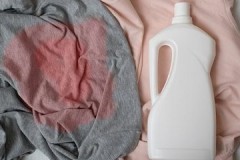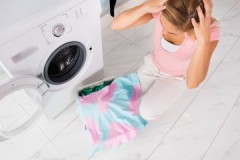How to properly wash the embroidery with a cross and not spoil it?
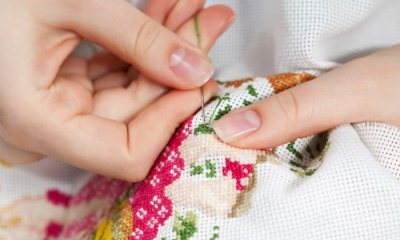 A cross-stitched product has a special value, like any other manual work. It can take several months to create a masterpiece.
A cross-stitched product has a special value, like any other manual work. It can take several months to create a masterpiece.
In the process of performing work, the fabric cloth inevitably gets dirty.
Read about whether and how to wash the finished cross stitch after finishing work and not spoil it in the article.
Content
Is it hand and machine washable?
It is necessary to erase the embroidery, since this procedure allows you to solve several problems at once:
- get rid of dust, stains and sebum;
- clean the canvas from small threads and lint;
- align the fabric;
- remove markup;
- fluff the floss;
- enhance the brightness of colors.
Key recommendations:
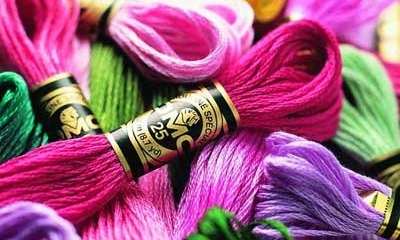 Hand-dyed threads... This material does not tolerate contact with any liquid, therefore such embroidery cannot be washed. Only dry cleaning is permissible.
Hand-dyed threads... This material does not tolerate contact with any liquid, therefore such embroidery cannot be washed. Only dry cleaning is permissible.- Mouline cotton... The threads are highly resistant to high temperatures, so the product can be washed by hand.
However, it is impossible to squeeze and twist the fabric, since the threads may not withstand the load and break.
- Cotton sectional dyed yarns... The product is washed at a temperature not exceeding 60 degrees.
- Mouline thread with glow effect... The maximum water temperature is 30 degrees.
- Mouline made of wool washed by hand in cool water. Wool does not tolerate spinning and contact with hot water.
Each manufacturer of the floss on the packaging indicates information regarding the washing method. These recommendations must be taken into account so as not to spoil the work.
If the threads are inexpensive, then the pigment from them will be actively washed out.... Washing in hot or even warm water can lead to sad consequences: shedding, the transition of a dark color to light areas. Therefore, such embroidery can only be processed by hand and at low temperatures.
Preparation for processing the finished product
Before starting the main wash, the product must be properly prepared.
Procedure:
- Remove the canvas from the hoop.
- Dust is removed by shaking it several times.
- If the preliminary marking was done with threads, they are removed.
- When the marking is applied with a marker, it must be washed off before the start of the main wash by rinsing the product under running water.
- Trim the edges of the fabric to prevent it from unraveling.
If the threads are prone to shedding, then the product requires preliminary color fixing. For this purpose, vinegar with a concentration of 9% is used.
To prepare the solution you will need:
- vinegar dining room - 1 tbsp. l;
- water 30 degrees - 1 liter.
In the prepared composition, the embroidery is soaked for 30 minutes. After this procedure, you can start the main wash. If the product sheds heavily, then add 1 tbsp to the solution. l. table salt.
Detergent selection
Cross-stitching can only be washed with liquid detergents. Conventional powder is not used for this purpose. Its particles will linger in the canvas, between the threads, which will lead to streaks and damage to the product.
Formulations suitable for washing embroidery:
-
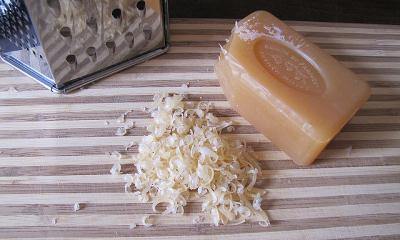 Liquid concentrates for hand washing. They should be designed to care for colored items.
Liquid concentrates for hand washing. They should be designed to care for colored items.These products include: Ariel gel (360 rubles), Persil Color gel (330 rubles), Losk Color gel (260 rubles), etc.
- Mild hair shampoo or liquid soap without added dyes.
- Laundry soap... Before washing, it must be crushed into shavings and thoroughly dissolved in water. You cannot rub the embroidery with soap.
Dishwashing gel is a controversial product. Some needlewomen claim that its use leads to color washout and thread thinning. Other craftswomen, on the other hand, always use it to wash their work.
If in doubt, you can test it on unused threads and track their reaction.
Washing rules
You need to wash the embroidery carefully; you cannot rub it or press it with your hands. If there are heavy dirt on the fabric, then clean it with a soft sponge from the wrong side. You need to work carefully so as not to catch knots and ruin the product.
Features of hand wash:
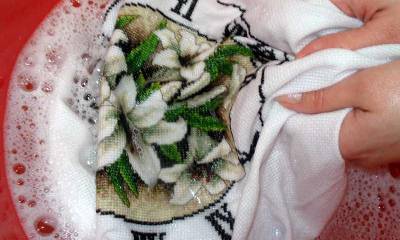 Water is collected in a basin and the selected detergent is diluted in it.
Water is collected in a basin and the selected detergent is diluted in it.- If the markings were applied with a marker, then the fabric is soaked only in cold soapy water. Boiling water will only aggravate the situation, as the paint is absorbed deeper into the fibers.
- Place the product in a basin so that it is completely covered with water. The linen should be level, so a large container is used for washing.
- Clean the fabric gently, wiping it with your palms or with a soft sponge on the wrong side.
- Rinse the product in running water until it becomes transparent.
There are several more ways to wash your embroidery. We need to dwell on each of them in more detail.
Stretching
You can wash the embroidery without removing it from the stretch (from a wooden or plastic hoop). To begin with, the picture is prepared for washing: the edges are processed, knocked out of dust, etc., and then pulled back onto the hoop. They are hung in the bathroom and watered from the shower.
The end of the wash is to thoroughly rinse the fabric in running water. It is convenient to use a shower for this.
Plain overlaid canvas
A regular invoice canvas is erased as follows:
- the canvas is slightly moistened using a spray bottle;
- after 5 minutes, the canvas is carefully removed, it will have time to get wet and become softer;
- wash the canvas by hand using liquid detergent.
Water-soluble canvas
The canvas with a water-soluble base is washed according to the following instructions:
- Prepare a saline solution (1 tsp for 0.5 l of water). The water should be cool.
- If the threads are not shed, the washing process is continued by soaking the canvas in hot water (about 50 degrees).
- When the mesh is completely dissolved, the garment is washed as usual.
Whitening after work
You cannot whiten the embroidery, but if the fabric surrounding the cross pattern turns yellow or gray, you need to take action. In order not to spoil the canvas during the cleaning process, you need to adhere to the following recommendations:
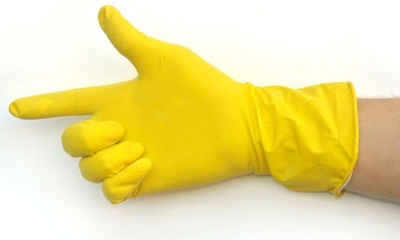 the selected bleaching composition is applied only to the fabric on which there are no stitches;
the selected bleaching composition is applied only to the fabric on which there are no stitches;- if there are colored threads next to the spots, then a cotton pad or even a cotton swab is used for processing;
- after cleaning is completed, the detergent is rinsed out under a strong pressure of water;
- the end of the whitening procedure is a regular wash.
Products that can safely bleach embroidery:
- Lemon juice... It is used in its pure form.
- Hydrogen peroxide... It is diluted with water in equal proportions.
- Ammonia... It is diluted with water in a 1: 3 ratio.
- Baking soda... It is mixed with water until a thick slurry is obtained.
All selected products are left on the fabric for 15-30 minutes, after which they proceed to the main wash.
How to dry and iron?
It is important not only to wash the embroidery correctly, but also not to spoil it during the drying and ironing process. To do this, you must observe the following rules:
- You cannot squeeze the canvas. Water should flow naturally over the canvas. It is placed vertically on the frame.
- You can spread the fabric on a flat surface by placing a towel underneath.
- To make the canvas dry faster, it is laid out on a towel and rolled into a roll. Mahra will absorb excess water.
- Do not hang the product on a rope and clamp it with clothespins. It is difficult to smooth out the creases that have appeared.
- It is not recommended to dry the canvas on a radiator or near other heat sources.
To give the embroidery rigidity, it is starchy. Instead of an iron, you can use a steam generator.
Helpful information
Before washing your cross stitch, you need to read the following information:
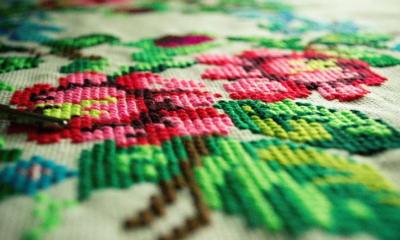 100% threads will shed if ink marks remain on the fingers during operation. In this case, you cannot do without pre-fixing the color.
100% threads will shed if ink marks remain on the fingers during operation. In this case, you cannot do without pre-fixing the color.- Do not wash fabric with metallized threads.
- If the product assumes the presence of additional decorative elements, then they are sewn on after the wash is completed.
- Washing with detergents is used only if there is serious dirt on the linen. When the product just needs to be freshened up, it is enough to rinse it in warm water.
Related Videos
How to wash and dry cross stitching, the video will tell you:
Conclusion
Cross stitching can only be erased by hand. For processing, use gentle detergents, be sure to take into account the type of thread and the manufacturer's recommendations for caring for the product. Processing should be gentle, stains are removed with non-aggressive detergents.

